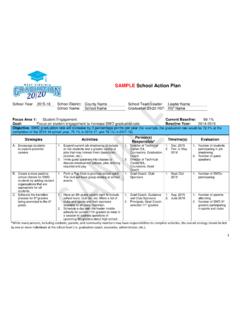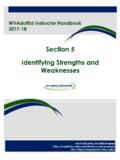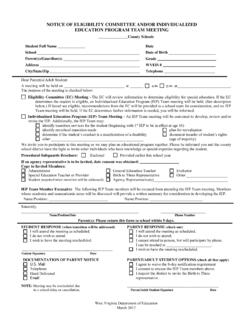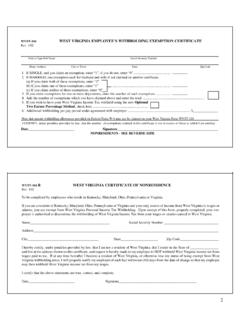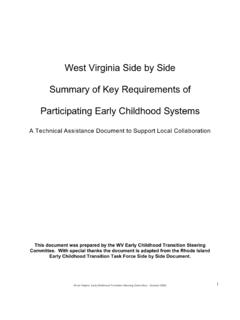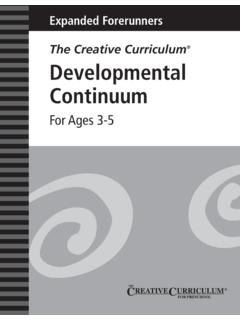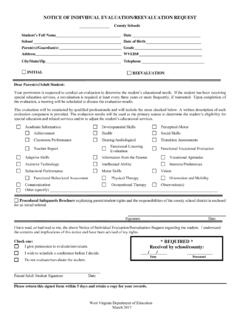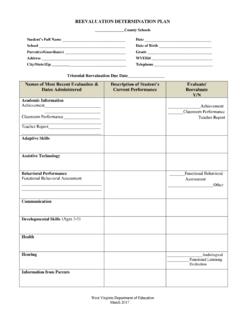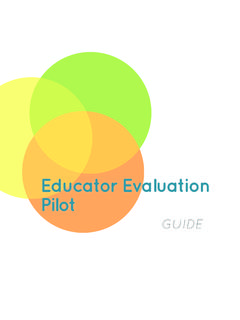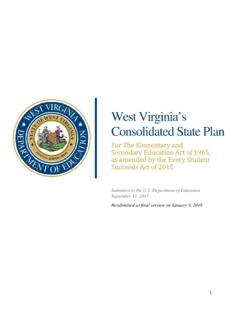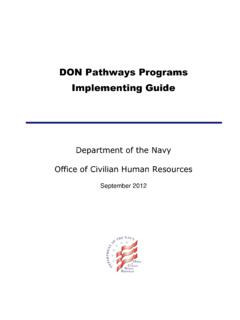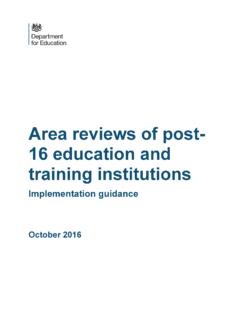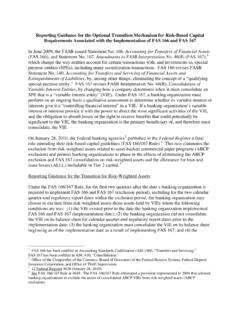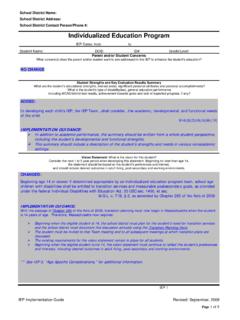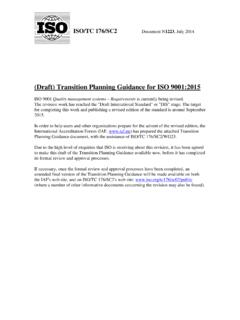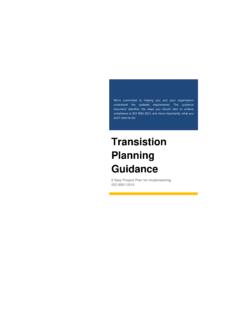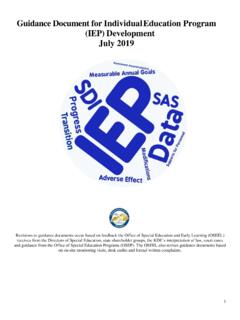Transcription of Evidence-Based TRANSITION PRACTICES AND PREDICTORS
1 Practice ProfileGuidance for West Virginia Schools and DistrictsJune 2015 West VirginiaEvidence-BasedTRANSITION PRACTICES AND PREDICTORSof Post School SuccessiTransition Practice Pro le | guidance for West Virginia Schools and DistrictsTransition &Practice ProfileSECTION I: Introduction ..1 SECTION II: Structure of Practice Profile ..2 SECTION III: Use of Practice Profile ..4 Using the Practice Profile as a Measure of IntegrityUsing the Practice Profile for Developing TRANSITION Action PlanSECTION IV: Review Process ..7 SECTION V: Frequently Asked Questions ..10 Table of ContentsThis document was adapted from RTI implementation Rubrics Guidebook prepared by Colorado Department of Education:RTI/PBIS Unit, 2011 and Innovation Configuration (IC) Teacher Preparation to Deliver Evidence-Based TRANSITION Planning and Services to Youth with Disabilities prepared by the Collaboration for Effective Educator, Development, Accountability and Reform (CEEDAR) Center, 2014 Note.
2 This guidance document is available at Practice Pro le | guidance for West Virginia Schools and DistrictsIntroductionRecognizing the need for strong guidance in TRANSITION implementation , WVDE has adapted an integrity tool to improve outcomes for students in West Virginia. This tool will support a scaling up of effective practice across the TRANSITION Practice Profile is a tool designed to assist schools and educators with the implementation of TRANSITION . The profile provides the means to reflect on policies and PRACTICES from the classroom level, to the school, district, regional and state level in order to continually improve outcomes for students.
3 This tool is intended to be used statewide and provide needed support in a continuous improvement cycle. The profile can also assist districts in their work toward accomplishing their goal of systemic change for increased student Components of TRANSITION :The Profile was developed based on the five components of TRANSITION as defined by West Virginia to assist educators with implementation and to provide a framework of reference for implementation that is contextually relevant. The five components of TRANSITION in West Virginia are: Student-Focused Planning Student Development Family Involvement Program Structure Interagency CollaborationThe Practice Profile can be used as:1.
4 An informational resourceThe Practice Profile outline what TRANSITION looks like across classrooms, schools, districts and RESAs. Educators can use the Practice Profile as a resource to learn about A way to measure implementationThe Practice Profile can be used by sites to identify how close they are in relation to the Full implementation stage of TRANSITION Tools to assist with planning and school improvementBecause the Practice Profile outline what TRANSITION looks like across four growth stages, sites can use the profile to identify goals for school planning or TRANSITION Action Practice Pro le | guidance for West Virginia Schools and DistrictsStructure of Practice ProfileIn this section the structure of the Practice Profile and how to use it is of the Structure of the Practice ProfileThe profile has been written for the school level.
5 The profile discusses the five TRANSITION components across each of the implementation stages. The profile has four implementation stages across four columns (see arrow labeled 1 ) and essential components in the far left column (see arrows labeled 2 and 3 ); thus, a matrix is created (see arrow labeled 4 ). The profile is written in a descriptive fashion, with the intention that it is applicable for grades six through 1: Snapshot view of School-Level Profile for Student-Focused PlanningThe essential components define best PRACTICES within the TRANSITION framework and provide a seamless flow between the components.
6 How each component is implemented will differ depending on the learners and other site specific variables (see Figure 1, arrow labeled 3 ). The essential components should facilitate discussion and focus educators in their implementation efforts. The common components allow educators to compare their progress between of Practice ProfileTRANSITION PRACTICES AND PREDICTORS OF POST SCHOOL SUCCESSS tudent-Focused Planning refers to an individualized set of courses, experiences, and curriculum designed to develop students academic and functional achievement to support the attainment of students desired post-school goals.
7 Involve students in TRANSITION IEPs Teach TRANSITION planning skills Include a comprehensive and relevant program of study in IEP Include appropriate and measurable TRANSITION goals in IEP Include systematic age-appropriate TRANSITION assessmentComponents1. Student-Focused PlanningExploration:Identifying NeedInstallation:Establishing ResourcesInitial implementation :Make AdjustmentsFull Involving students in TRANSITION leadership and staff identify the need for change, learning about possible interventions that may be solutions, creating readiness for change, learning about what it takes to implement the innovation leadership and staff commits to TRANSITION by.
8 Collaborating with general education teachers to embed choices into the general curriculum and daily lessons and provide opportunities for students to practice self-determination skills Utilize a student driven IEP process to allow students to demonstrate self-awareness, goal setting, problem solving, and self-advocacy Provide opportunities for students to develop self-awareness by engaging in honest and respectful discussions with students about their self-determination assessment responses Provide direct instruction in self-determination using a structured curriculum or Evidence-Based instructional strategy.
9 With guided practice in natural school and community- based settings Expect and support students to make many routine choices for themselves through the course of a school day Work collaboratively with students to facilitate achievement of their goals by informing them of their options and the potential consequences of their choicesUsing curricula and EBPs to promote student involvement in TRANSITION IEPSelf-Advocacy StrategySelf-Directed Teaching TRANSITION planning skills (practice and PREDICTORS ).School leadership and staff identify the need for change aligning TRANSITION planning skills to goals to implement the innovation leadership and staff commits to TRANSITION by.
10 Provide systems level infrastructure to monitor and guide students to obtain post-school goals use interagency collaboration with clearly defined roles and responsibilities to provide coordinated TRANSITION services Provide integrated instruction in all areas of independent living for all students with disabilities Provide instruction and training in natural environments supported by classroom instruction Monitor and assess students progress in the domains of academics, daily living, personal and social and occupational Use multiple strength- based assessments across multiple domains at different points in time to assist student and IEP teams in post-school planningKnowledge of TRANSITION planningSkills to set and attain goals12343 TRANSITION Practice Pro le | guidance for West Virginia Schools and DistrictsStructure of Practice ProfileThe profile describes what TRANSITION looks like as implementation evolves across the four implementation stages: Exploration, Installation, Initial implementation and Full implementation .
